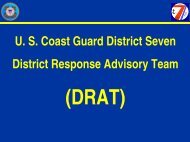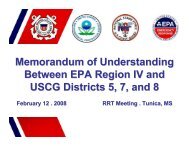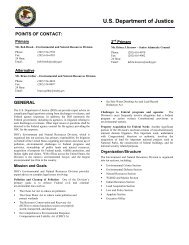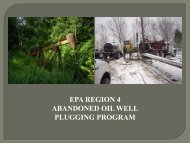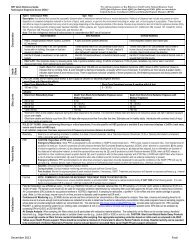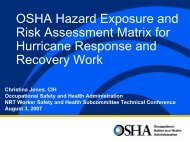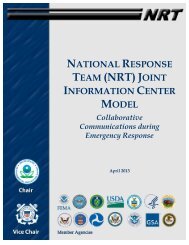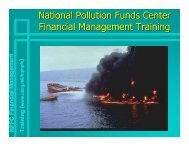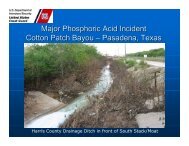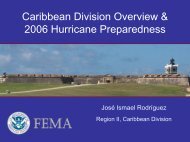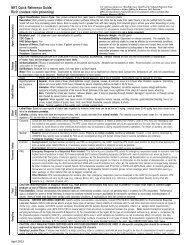USE OF DISPERSANTS - U.S. National Response Team (NRT)
USE OF DISPERSANTS - U.S. National Response Team (NRT)
USE OF DISPERSANTS - U.S. National Response Team (NRT)
- No tags were found...
Create successful ePaper yourself
Turn your PDF publications into a flip-book with our unique Google optimized e-Paper software.
to order the use of dispersants or chemical agents, subject to the following conditions:405.1 The use of dispersants or chemical agents is authorized only after all methods of physicalor mechanical removal are judged by the OSC to be infeasible.405.2 The pre-designated authority to use dispersants or chemical agents on oil discharges inaccordance with this Agreement is vested solely in the individual who is the predesignatedUSCG OSC. This authority will not be delegated.405.3 The decision to use dispersants or chemical agents shall be made only after consulting thePuerto Rico Coastal Atlas for Sensitivity of Coastal Environments and Wildlife to SpilledOil and the decision guidelines for dispersant use detailed in Subpart J of the Region IIRegional Contingency Plan (Part 2600 of the USCG Local Contingency Plan).405.4 Dispersants or chemical agents will be used only when they are expected to prevent orminimize substantial threat to public health or welfare, or serious environmental damage.405.5 Dispersants or chemical-agents may be used only in open waters that are at least 0.5nautical miles from any shoreline and where the water depth is greater than 60 feet deep.405.6 Dispersants or chemical agents shall not be used in, on, or over waters containing reefs;waters designated as marine reserves; mangrove areas; or waters in coastal wetlands;except with the prior and express concurrence of the PRDNR and <strong>USE</strong>PA, inconsultation with USDOC and USDOI. Coastal wetlands include:1) Submerged algal beds (rocky or unconsolidated bottom);2) Submerged seagrass beds; and3) Coral reefs405.7 Dispersants or chemical agents shall not be used in fresh or brackish waters.405.8 As a general rule,, if a discharge is too small to be removed by alternative mechanicalmethods, it is too small to consider the application of dispersants or chemical agents.405.9 Sinking agents are not dispersants and shall not be considered as authorized chemicalagents. Use of sinking agents is expressly prohibited by this Agreement and the <strong>National</strong>Contingency Plan.405.10 If an oil discharge poses an imminent threat to a sensitive area restricted by protocol405.5, the USCG OSC must contact <strong>USE</strong>PA and PRDNR for concurrence, and consultwith USDOC and USDOI. If <strong>USE</strong>PA and PRDNR disagree, the opinion of PRDNR shallprevail. If PRDNR provides no answer within 4 hours, <strong>USE</strong>PA's decision will prevail. Inthe event that neither PRDNR nor <strong>USE</strong>PA can provide an answer within 4 hours, theUSCG OSC may proceed with the dispersant or chemical agent application if the threatrepresents a substantial threat to public health or welfare, or serious environmentaldamage is imminent if dispersants or chemical agents are not used.405.11 Any use of dispersants or chemical agents requires that a post incident debriefing takeplace within 45 days after the first application of dispersants or chemical agents. The



